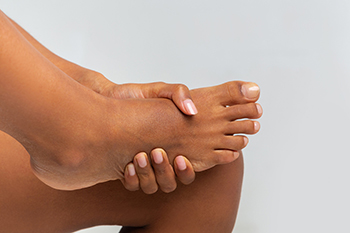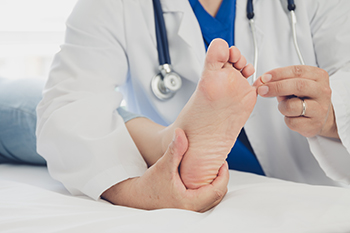Items filtered by date: August 2023
Bone Spurs on Top of the Foot

Bone spurs on the top of the foot can be a discomforting issue. These protrusions, though not typically sharp, can cause pain by pressing against nearby bones, tendons, ligaments, or nerves. Age is often linked to bone spurs on top of the foot. Over time, the wearing down of cartilage can result in diminished joint cushioning, leading to friction, and, resulting in a spur growth. Engaging in certain activities, such as running or dancing, can also trigger bone spurs on the foot. The repetitive stress from these activities can cause trauma, prompting the body to generate extra calcium. Uncomfortable or ill fitting shoes, whether too tight or shaped inadequately, can cause friction that leads to trauma and bone spur formation. Additionally, injuries ranging from minor bruises to significant bone fractures can lead to calcium accumulation, which may result in bone spurs. Swelling, redness, tenderness and pain warrant prompt medical attention. If you have noticed a bone spur on the top of your foot, it is suggested that you make an appointment with a podiatrist for an exam, diagnosis, and a treatment plan that is correct for you.
Foot Pain
Foot pain can be extremely painful and debilitating. If you have a foot pain, consult with Kenneth Williams, DPM from Texas. Our doctor will assess your condition and provide you with quality foot and ankle treatment.
Causes
Foot pain is a very broad condition that could be caused by one or more ailments. The most common include:
- Bunions
- Hammertoes
- Plantar Fasciitis
- Bone Spurs
- Corns
- Tarsal Tunnel Syndrome
- Ingrown Toenails
- Arthritis (such as Gout, Rheumatoid, and Osteoarthritis)
- Flat Feet
- Injury (from stress fractures, broken toe, foot, ankle, Achilles tendon ruptures, and sprains)
- And more
Diagnosis
To figure out the cause of foot pain, podiatrists utilize several different methods. This can range from simple visual inspections and sensation tests to X-rays and MRI scans. Prior medical history, family medical history, and any recent physical traumatic events will all be taken into consideration for a proper diagnosis.
Treatment
Treatment depends upon the cause of the foot pain. Whether it is resting, staying off the foot, or having surgery; podiatrists have a number of treatment options available for foot pain.
If you have any questions, please feel free to contact our office located in San Antonio and Beeville, TX . We offer the newest diagnostic and treatment technologies for all your foot care needs.
Podiatry as a Career Choice

Podiatry, a medical field focusing on foot and lower leg conditions, is an option that appeals to those interested in patient care without a traditional medical school. To determine if podiatry suits you, it is important to understand its benefits and the skills needed. Podiatrists diagnose, treat, and perform procedures, such as setting broken bones and prescribing medications. They have distinct educational paths and professional organizations, offering flexible work arrangements in private practices or hospitals. Reasons to consider podiatry include work-life balance, impact on patients' lives, and diverse specializations, such as sports medicine or surgery. In addition, this profession offers varied patient populations, high demand, innovation, good pay, job stability, independence, and favorable work environments. Skills like interpersonal communication, critical thinking, dexterity, and research are vital for effective podiatry practice. If you are considering pursuing podiatry as a career choice, it is suggested that you make an appointment with a practicing podiatrist to see what it is really like to perform this role.
If you are experiencing pain in the feet or ankles, don’t join the stubborn majority refusing treatment. Feel free to contact Kenneth Williams, DPM from Texas. Our doctor can provide the care you need to keep you pain-free and on your feet.
What Is a Podiatrist?
Someone would seek the care of a podiatrist if they have suffered a foot injury or have common foot ailments such as heal spurs, bunions, arch problems, deformities, ingrown toenails, corns, foot and ankle problems, etc.
Podiatric Treatment
A podiatrist will treat the problematic areas of the feet, ankle or lower leg by prescribing the following:
- Physical therapy
- Drugs
- Orthotic inserts or soles
- Surgery on lower extremity fractures
A common podiatric procedure a podiatrist will use is a scanner or force plate which will allow the podiatrist to know the designs of orthotics. Patients are then told to follow a series of tasks to complete the treatment. The computer will scan the foot a see which areas show weight distribution and pressure points. The podiatrist will read the analysis and then determine which treatment plans are available.
If you have any questions please feel free to contact our office located in San Antonio and Beeville, TX . We offer the newest diagnostic and treatment technologies for all your foot and ankle needs.
Foot Conditions May Happen From Wearing Flip-Flops
 Wearing flip-flops is a popular thing to do in the summer months. They are easy to wear and come in many different materials and colors. Ideally, they are meant to be worn to the beach and pool areas, however, many people enjoy their simplicity and choose to wear them while accomplishing daily tasks. When flip flops are frequently worn, the walking style or gait may change as the foot muscles adapt to ensure the shoe is comfortable. Blisters may form, toenail fungus and athletes’ foot may develop, and heel pain may ensue. There is generally minimal padding on the heels of flip flops, and ongoing heel pain may indicate plantar fasciitis or that a heel spur has occurred. Additionally, hammertoe may develop as the toes continuously scrunch together to keep the shoe on the foot. Cracked heels are another condition that can happen from wearing shoes that do not have a back, and it is helpful to moisturize the feet more often when these types of shoes are worn. If you have concerns about wearing flip-flops, it is suggested that you confer with a podiatrist who can answer any questions you may have.
Wearing flip-flops is a popular thing to do in the summer months. They are easy to wear and come in many different materials and colors. Ideally, they are meant to be worn to the beach and pool areas, however, many people enjoy their simplicity and choose to wear them while accomplishing daily tasks. When flip flops are frequently worn, the walking style or gait may change as the foot muscles adapt to ensure the shoe is comfortable. Blisters may form, toenail fungus and athletes’ foot may develop, and heel pain may ensue. There is generally minimal padding on the heels of flip flops, and ongoing heel pain may indicate plantar fasciitis or that a heel spur has occurred. Additionally, hammertoe may develop as the toes continuously scrunch together to keep the shoe on the foot. Cracked heels are another condition that can happen from wearing shoes that do not have a back, and it is helpful to moisturize the feet more often when these types of shoes are worn. If you have concerns about wearing flip-flops, it is suggested that you confer with a podiatrist who can answer any questions you may have.
Flip-flops are not always the best choice of footwear. If you have any concerns about your feet or ankles, contact Kenneth Williams, DPM from Texas. Our doctor will assist you with all of your foot and ankle needs.
Flip-Flops and Feet
When the weather starts warming up, people enjoy wearing flip-flops. Flip-flops are comfortable, stylish, and easy to slip on and off; they're perfect for any summer beach goer. However, these shoes can cause harm to the feet.
How Can Flip-Flops Affect Me Long-Term?
- Ankle problems
- Hip problems
- Lower back problems
- Pain in the balls of the feet
- Problems with foot arches
- Changes in the way you walk
Are There Injuries Associated with Flip-Flops?
Yes. Since flip-flops are relatively weak and do not provide the same amount of support as sneakers, people who wear flip-flops regularly are more susceptible to injuries. On top of that, the open nature of the shoe makes your feet more prone to other problems, such as cuts and even infections. Common injuries and ailments include:
- Sprained ankles
- Blisters
- Infections
- Cuts and Scrapes
I like Wearing Flip-Flops. Are There Safe Alternatives?
When buying flip-flops, try to find ones that have sturdy soles and that are made of high-quality materials that will support for your feet. These flip-flops will cost more but will also last longer as a result.
If you have any questions please feel free to contact our office located in San Antonio and Beeville, TX . We offer the newest diagnostic and treatment technologies for all your foot and ankle needs.
How Stress Fractures Occur

Stress fractures often occur in the feet, and can be caused by frequently participating in running and jumping activities. A stress fracture is considered to be a hairline fracture and can be uncomfortable. A patient who has a stress fracture will experience gradual pain, and many people will continue to pursue their chosen activity until walking becomes difficult. At this point, an X-ray or other imaging test can be performed to determine the severity of the stress fracture. Treatment can begin with temporarily stopping the activity and resting the foot as often as possible. Some people choose to wear a protective boot or walking cast, which can provide mobility and stability as the healing process occurs. Stress fractures can also occur from increasing speed and distance too quickly, or from wearing shoes that do not fit correctly. If you have foot pain, and think it may be from a stress fracture, it is suggested that you confer with a podiatrist who can effectively diagnose and treat this condition.
Activities where too much pressure is put on the feet can cause stress fractures. To learn more, contact Kenneth Williams, DPM from Texas. Our doctor can provide the care you need to keep your pain free and on your feet.
Dealing with Stress Fractures of the Foot and Ankle
Stress fractures occur in the foot and ankle when muscles in these areas weaken from too much or too little use. The feet and ankles then lose support when walking or running from the impact of the ground. Since there is no protection, the bones receive the full impact of each step. Stress on the feet can cause cracks to form in the bones, thus creating stress fractures.
What Are Stress Fractures?
Stress fractures occur frequently in individuals whose daily activities cause great impact on the feet and ankles. Stress factors are most common among:
- Runners
- People affected with Osteoporosis
- Tennis or basketball players
- Gymnasts
- High impact workouts
Symptoms
Pain from the fractures occur in the area of the fractures and can be constant or intermittent. It will often cause sharp or dull pain with swelling and tenderness. Engaging in any kind of activity which involves high impact will aggravate pain.
If you have any questions please feel free to contact our office located in San Antonio and Beeville, TX . We offer the newest diagnostic and treatment technologies for all your foot and ankle needs.
